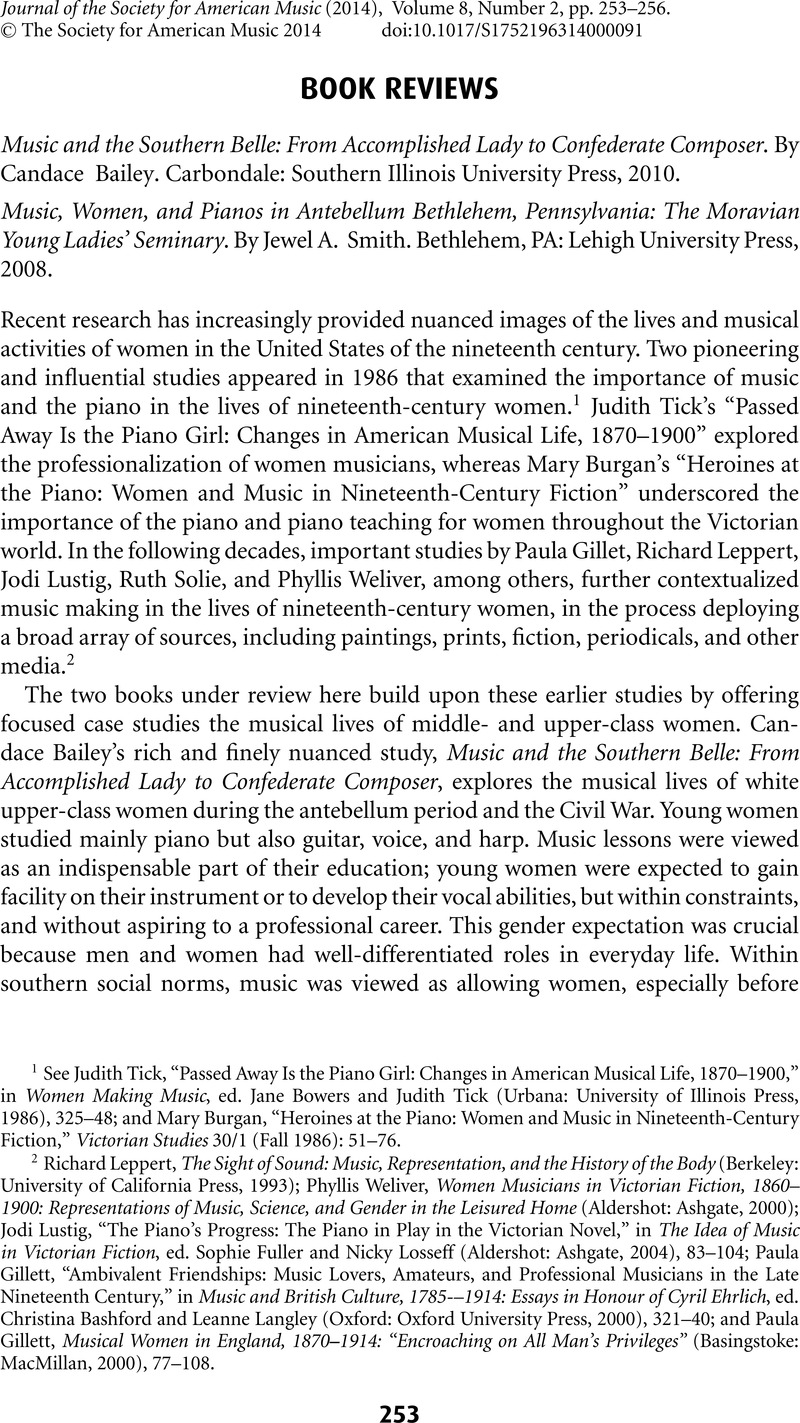No CrossRef data available.
Article contents
Music and the Southern Belle: From Accomplished Lady to Confederate Composer. By Candace Bailey. Carbondale: Southern Illinois University Press, 2010. - Music, Women, and Pianos in Antebellum Bethlehem, Pennsylvania: The Moravian Young Ladies’ Seminary. By Jewel A. Smith. Bethlehem, PA: Lehigh University Press, 2008.
Published online by Cambridge University Press: 04 June 2014
Abstract

- Type
- Book Review
- Information
- Journal of the Society for American Music , Volume 8 , Issue 2: Musical Women in Nineteenth-Century America , May 2014 , pp. 253 - 256
- Copyright
- Copyright © The Society for American Music 2014
References
1 See Tick, Judith, “Passed Away Is the Piano Girl: Changes in American Musical Life, 1870–1900,” in Women Making Music, ed. Bowers, Jane and Tick, Judith (Urbana: University of Illinois Press, 1986), 325–48CrossRefGoogle Scholar; and Burgan, Mary, “Heroines at the Piano: Women and Music in Nineteenth-Century Fiction,” Victorian Studies 30/1 (Fall 1986): 51–76Google Scholar.
2 Leppert, Richard, The Sight of Sound: Music, Representation, and the History of the Body (Berkeley: University of California Press, 1993)Google Scholar; Weliver, Phyllis, Women Musicians in Victorian Fiction, 1860–1900: Representations of Music, Science, and Gender in the Leisured Home (Aldershot: Ashgate, 2000)Google Scholar; Lustig, Jodi, “The Piano's Progress: The Piano in Play in the Victorian Novel,” in The Idea of Music in Victorian Fiction, ed. Fuller, Sophie and Losseff, Nicky (Aldershot: Ashgate, 2004), 83–104Google Scholar; Gillett, Paula, “Ambivalent Friendships: Music Lovers, Amateurs, and Professional Musicians in the Late Nineteenth Century,” in Music and British Culture, 1785–1914: Essays in Honour of Cyril Ehrlich, ed. Bashford, Christina and Langley, Leanne (Oxford: Oxford University Press, 2000), 321–40Google Scholar; and Gillett, Paula, Musical Women in England, 1870–1914: “Encroaching on All Man's Privileges” (Basingstoke: MacMillan, 2000), 77–108CrossRefGoogle Scholar.
3 See also Bailey's article “The Antebellum ‘Piano Girl’ in the American South,” which is similar to chapter 5 in her Music and the Southern Belle. Bailey, “The Antebellum ‘Piano Girl’ in the American South,” Performance Practice Review 13 (2008), http://scholarship.claremont.edu/ppr/vol13/iss1/.
4 Loesser, Arthur, Men, Women and Pianos: A Social History (New York: Simon and Schuster, 1954)Google Scholar.
5 In addition to their school in Pennsylvania, the Moravians operated a very successful school for young women in Salem, the town they founded in North Carolina.


